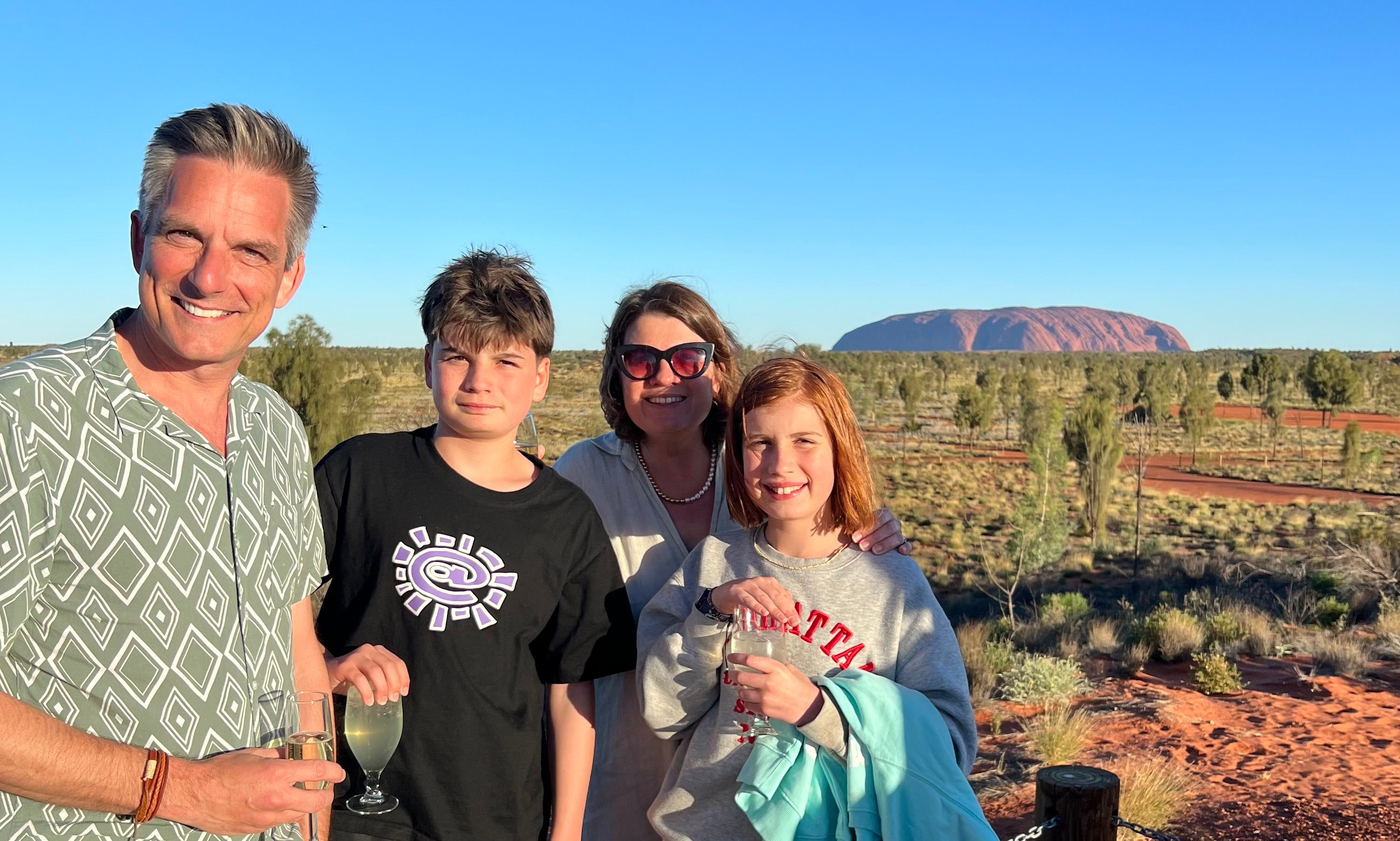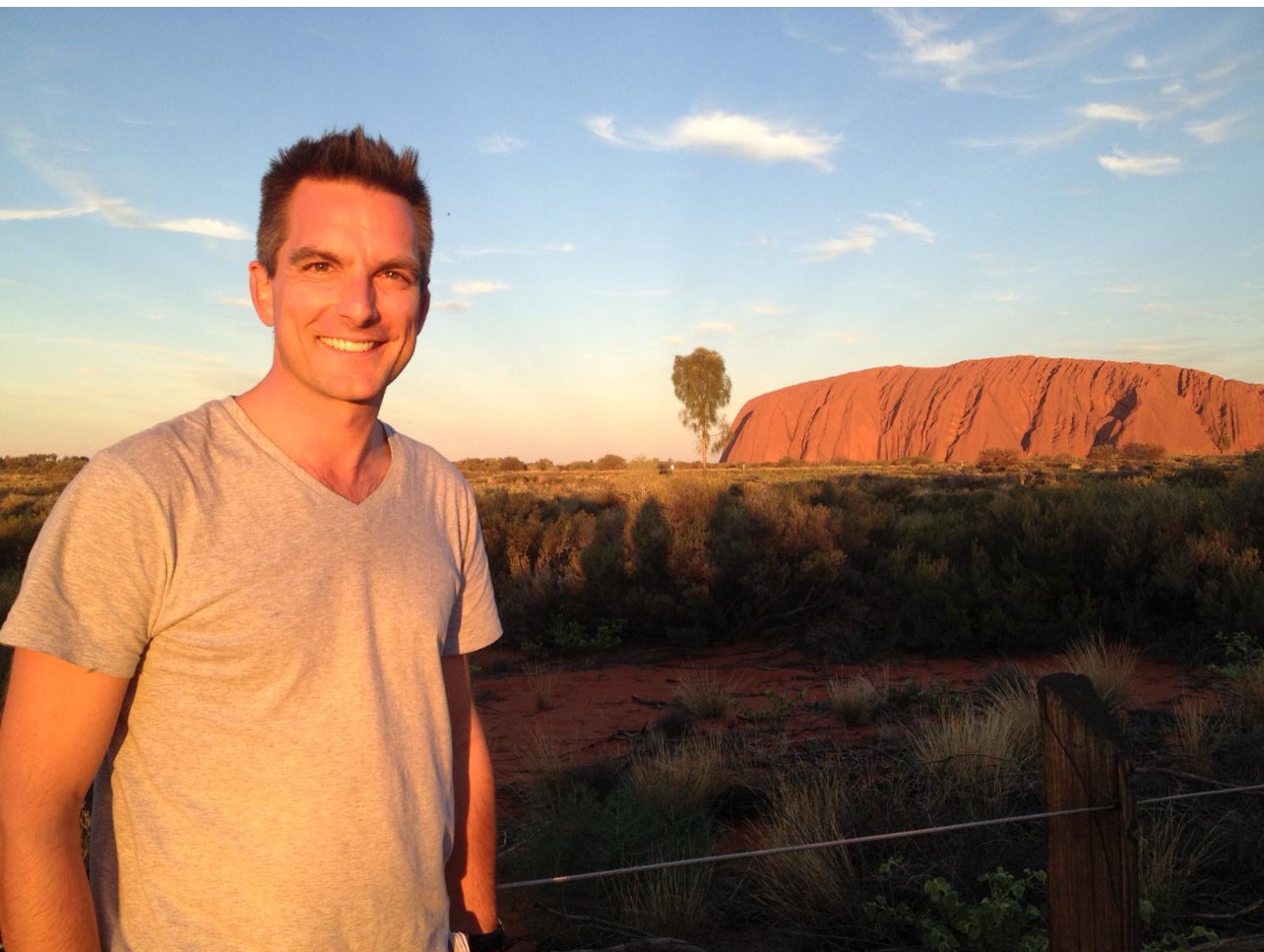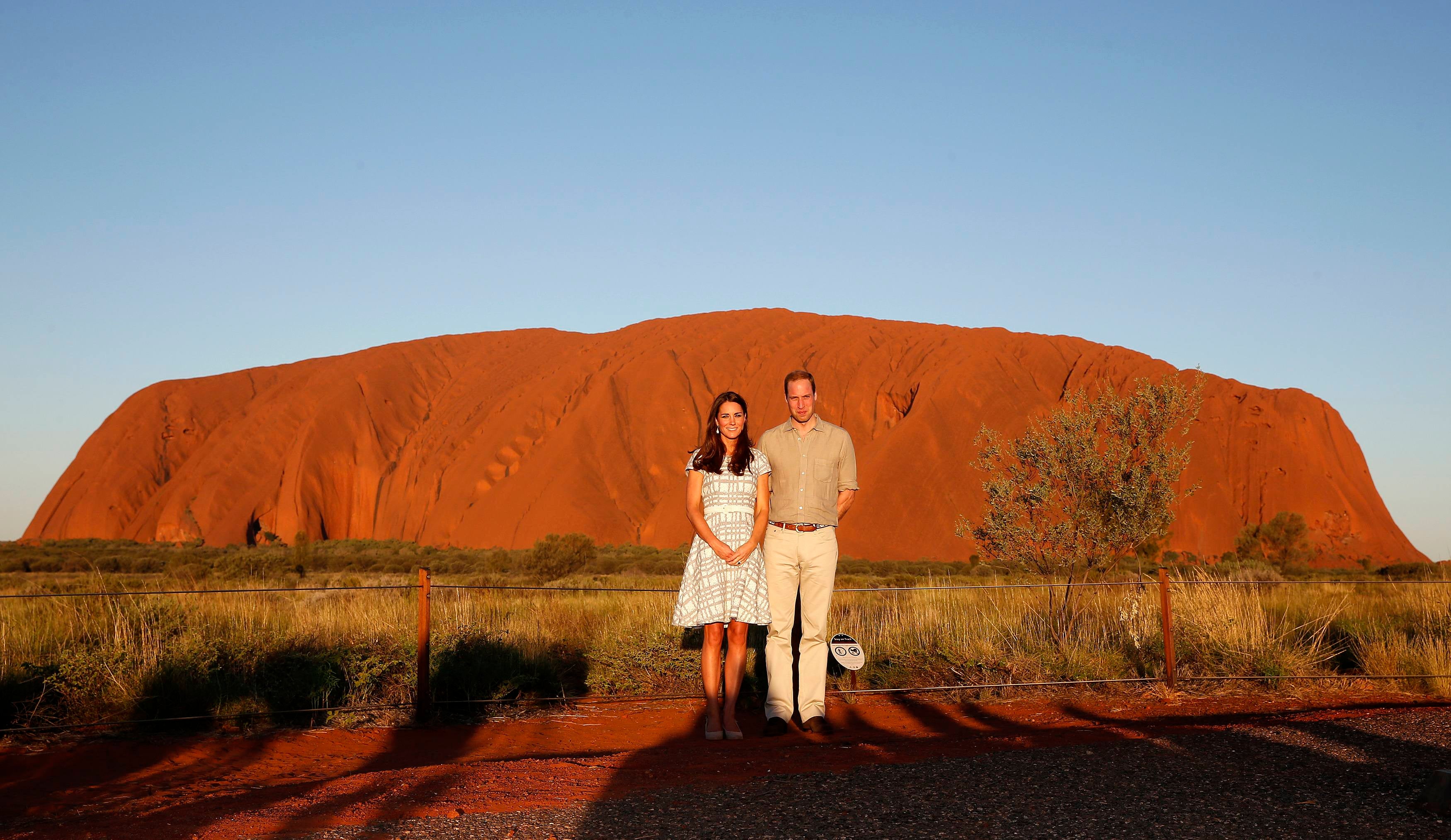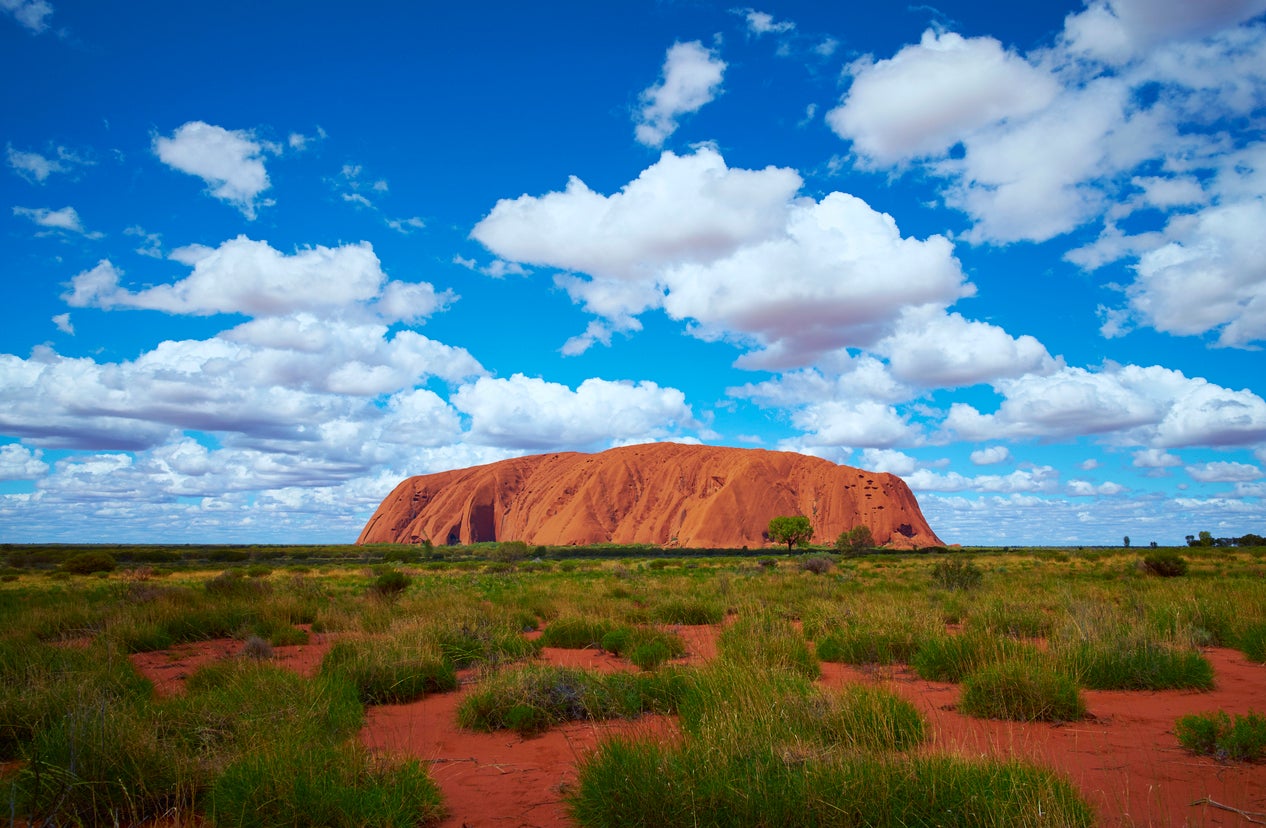Ten years ago I visited Uluru with William and Kate – now I am back with my own family
After following the royals to the same spot 10 years ago, Jonathan Samuels is back with his family to experience Uluru’s ancient offerings, camel rides and the rock’s golden hour

A decade ago, I joined a huge group of international journalists standing in the red dirt of the Australian Outback, craning our necks, pointing our cameras and sweating in the relentless heat. We were waiting for the then Duke and Duchess of Cambridge to appear.
As the sun began its slow descent towards the horizon, William and Kate finally emerged after their guided walk around the giant rock that is Uluru.
The couple were on tour in Australia and New Zealand with baby Prince George and had come to experience the sandstone landmark for themselves. Posing slightly awkwardly, the couple gave the “Aussie salute”, waving away the flies which refused to leave any of us alone, royal or otherwise.
Comparisons were made with Charles and Diana’s similar trip 30 years earlier and their equally awkward photo call.
The royal family has been through a huge amount of change since that trip, but what hasn’t changed is the beauty and grandeur of Uluru. While Uluru remains rock steady, around it there is constant evolution with new creative and immersive ways of enjoying this ancient site.

So exactly 10 years after it first made an impression on me, I am back, this time with my family.
As we flew towards the sunburnt heart of Australia, I shared some facts with the kids about this “rock star”. It’s about 600 million years old and used to sit on the bottom of an ancient seabed. It’s the world’s largest single rock, taller than the Eiffel Tower and, like an iceberg, most of it is out of view underground.
What must surveyor William Gosse have thought when he stumbled across the landmark in 1873? He named it after the then chief secretary of South Australia, Sir Henry Ayers. In 1993, it was returned to the traditional Aboriginal name Uluru.
It is hard to describe how staggeringly beautiful Uluru is. Its colour constantly shifts as the sun sets, from rusty red to orange to crimson and all shades in between. Shadows slowly move across the rock until it is completely in darkness. When the sun rises the colours reappear in reverse.
Read more: The best Australia holidays to do in your lifetime
Both Uluru and the nearby Kata Tjuta rock formation have huge cultural significance for the local Anangu, the traditional owners of the area. The Anangu still centre themselves around their ancient traditions, laws and stories passed down from generation to generation. They believe the landscape was formed at the beginning of time by ancestral beings and it is their duty as direct descendants to protect it. The land and their lives are entwined.

Anangu is one of the oldest surviving cultures on the planet – 60,000 years old – but it is through the latest technology that visitors get the chance to learn more about them.
At dusk, and with a drink in hand, we gathered on a viewing platform perched on a desert dune to watch the rock bathed in the warm colours of the “golden hour”.
Wintjiri Wiru means “beautiful view out to the horizon” in the local Pitjantjatjara language, and once darkness fell, 1,100 drones rose into the air, joined by lasers, projections, music and narration for a storytelling experience like no other.
Under the stars, we watched as the story played out, recounting the evil shape-shifting spirit sent to destroy the Mala people. We gazed up as the illuminated drones also shifted shape, culminating with a dramatic finale 200 metres above us, as the spirit morphed into a giant devil dog.

It is the world’s largest permanent drone show and depicts just one chapter of the ancient Mala story, from the Kaltukatjara community west of Uluru, to the base of the rock.
As we sat in the open-air theatre, we tucked into a gourmet dinner hamper, including smoked emu, blackened pepper leaf kangaroo, cheeses and salad. Then, as the air chilled around us, our thoughts turned to sunrise and seeing Uluru once more.
Read more: How travellers are seeking out Australia’s hot springs
It was an early start the next day, and a 6am bus collection transported us not for more fancy drinks and nibbles but to... a camel farm.
Camels were imported to Australia in the 19th century to help with transportation and construction. Some escaped or were released and now there are an estimated 1 million wild camels roaming free.

Some have been caught and tamed and now plod happily through the spectacular desert landscape with tourists on their backs. My son and I mounted Sterlo (friendly, but prone to nibbling the camel in front), while my wife and daughter rode Trigger (once the fastest racing camel in Australia, now enjoying a more sedate life).
In a long camel train led by the cameleers, we trekked through the spikey green spinifex and mulga grass towards Uluru as the sun hit the rock and the colours came to life, ignited in a blaze of colour, making for a slightly surreal but unforgettable experience.
Read more: This popular island was ravaged by fires – here’s what it’s really like to go back
“We are closer to the International Space Station than the nearest McDonald’s” said our stargazing guide on our last night as he pointed out planets and stars in the southern sky. The lack of light pollution means the heavens here are brighter than almost anywhere else on Earth.
As the outdoor-Outback dinner came to an end, our gaze moved from the skies to the ground as a wave of colour flooded the space in front of us, the size of seven football fields. Fifty thousand lights on swaying stalks make up the Field of Light, an immersive art installation by British artist Bruce Munro.
This is an ancient land and home to an ancient people. But the mysticism and magic of their stories is still captivating 21st-century crowds.
Where to stay
Ayers Rock Resort has accommodation to suit everyone from royals to backpackers.
The luxurious Sails in the Desert has rooms from AU$500 (£260) per night.
Alternatively, try the Outback Hotel and Lodge – share a dorm room from AU$38 (£20) per night.
Book sunrise, sunset and daytime camel tours at ulurucameltours.com.au
Kulata Academy Café is a great spot for light meals and drinks and where trainees of the National Indigenous Training Academy prepare for careers in hospitality.
How to get there
Fly direct to Ayers Rock airport from Melbourne, Sydney, Cairns and Brisbane very soon. It is a 20-minute drive to the National Park entrance; hotels run shuttle buses. A number of airlines fly to Australia, including British Airways, Qatar, Emirates and Singapore Airlines. Flight time to the east coast is around 22 hours.
Read more: The best beaches in Australia
Join our commenting forum
Join thought-provoking conversations, follow other Independent readers and see their replies
Comments
Bookmark popover
Removed from bookmarks